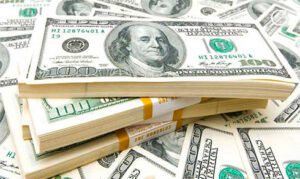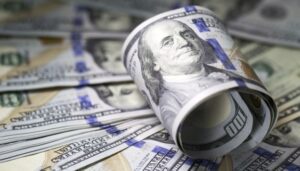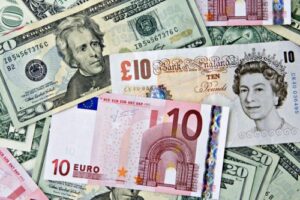
The US dollar is moderately declining against major world currencies on Thursday morning, investors evaluate the statements of the Federal Reserve Board and statistical data.
The ICE-calculated index, which shows the dynamics of the US dollar against six currencies (the euro, the Swiss franc, the yen, the Canadian dollar, the pound sterling and the Swedish krona), is down 0.2%, the broader WSJ Dollar is down 0.25%.
The euro/dollar pair is trading at $0.9920 by 9:08 Moscow time compared to $0.9885 at the close of the session on Wednesday, the euro adds about 0.35%.
The exchange rate of the American currency against the yen is reduced by 0.1% and amounts to 144.53 yen compared to 144.69 yen the day before.
The pound rose 0.1% to $1.1335 compared to $1.1327 at the close of the previous session.
The day before, the head of the Federal Reserve Bank of Atlanta, Rafael Bostic, said that he supports raising the key interest rate in the US by another 125 basis points by the end of the year, to 4.5%.
Meanwhile, San Francisco Fed colleague Mary Daly told CNN that the central bank should raise borrowing costs even higher and keep them high until inflation starts approaching 2%.
It became known yesterday that the index of business activity in the US services sector (ISM Non-Manufacturing) in September decreased to 56.7 points compared to 56.9 points a month earlier, data from the Institute of Supply Management (ISM) showed. Analysts, on average, assumed a more significant drop, to 56 points, according to Trading Economics.
Now all the attention of market participants is directed to data on the US labor market, which will be published on Friday. Experts believe that the unemployment rate in the country in September remained at the August mark of 3.7%, and the number of new jobs increased by 315 thousand people.

The dollar strengthens against the euro, yen and pound sterling in trading on Wednesday after a sharp decline the day before amid signals of a gradual decline in activity in the US economy.
Investors are waiting for data on the US labor market, which is expected to show a slowdown in job growth in the country. The consensus forecast of experts surveyed by Market Watch suggests that the number of jobs in September increased by 275 thousand (315 thousand in August), while maintaining unemployment at 3.7%.
The US Department of Labor will release the data on Friday at 3:30 p.m.
Another report from the Department of Labor, which was published on Tuesday, showed a sharp decrease in the number of open vacancies in the States in August. The indicator fell by 10% – the fastest pace since the start of the pandemic in 2020, to 10.1 million vacancies.
Weak statistics on the US economy are a good signal for risk appetite, as they speak in favor of a reduction in the trajectory of the Federal Reserve (Fed) rate hike, said Steven Innes, managing partner at SPI Asset Management.
Some “cooling” of the labor market will help ease inflation in the US and may reduce the need for further sharp tightening of monetary policy by the Fed, writes Dow Jones.
“If this trend continues, the Fed may back off somewhat in terms of rate hikes later this year and early next year,” said Jack Janasiewicz, portfolio manager at Natixis Investment Managers Solutions.
The euro/dollar pair is trading at $0.9966 on Wednesday, compared to $0.9987 at the close of previous trading. The pound fell to $1.1435 from $1.1475 at the close of previous trading.
The US dollar against the yen is 144.25 yen against 144.14 yen the day before.
On Tuesday, the dollar lost 1.7% against the euro, 1.4% against the pound and 0.3% against the yen.

The ICE-calculated index showing the dynamics of the dollar against six currencies (the euro, the Swiss franc, the yen, the Canadian dollar, the pound sterling and the Swedish krona) loses 0.11% during trading, the broader WSJ Dollar Index – 0.08%.
The euro/dollar pair is trading at $0.9846 compared to $0.9825 at the close of previous trading. The pound rose to $1.1361 compared to $1.1322 at the close of previous trading.
The US dollar against the yen is 144.75 yen against 144.56 yen the day before.
On Monday, the dollar lost 0.2% against the euro, 1.4% against the pound and 0.1% against the yen.
The weakening of the US currency was facilitated by statistical data showing a decrease in the index of business activity in the US manufacturing sector in September to the lowest level since May 2020. They were taken by the market as a signal that the Fed would have to stop the rate hike cycle earlier than expected in order to avoid a sharp decline in economic activity, Trading Economics notes.
The ISM Manufacturing Index fell to 50.9 last month from 52.8 a month earlier, according to the Institute for Supply Management (ISM). Analysts on average expected it to fall to 52.2 points, according to Trading Economics.
On Friday, September data on the US labor market will be released, which is expected to show a slowdown in US job growth. The consensus forecast of experts polled by Market Watch assumes an increase in the number of jobs in September by 275 thousand (315 thousand in August), while maintaining unemployment at 3.7%.
The dollar-denominated ICE index rose 7.2% in the third quarter, the biggest quarterly jump since 2015, according to Dow Jones data. In September, its value increased by 3.2%. The dynamics of the index for the whole of 2022 may be the best since 2014, when it grew by almost 13%.

The Japanese yen is depreciating against the US dollar on Monday morning.
The US dollar exchange rate against the yen at 8:56 am CST was 144.8 yen compared to 144.72 yen on Friday. During the session, the yen fell below 145 yen per $1, which could provoke the Japanese government to conduct foreign exchange intervention for the second time this year, writes Bloomberg.
The Japanese currency fell to 145.9 yen per dollar on September 22, after which the country’s Ministry of Finance decided to intervene in the foreign exchange market for the first time in 24 years. In total, authorities spent 2.84 trillion yen ($19.65 billion) in September to support the national currency, the ministry said.
The weakening of the yen comes against the backdrop of the Bank of Japan maintaining a loose monetary policy, while other central banks of the world have begun to tighten it due to inflation, beating multi-year records. In total, the yen has lost 21% since the beginning of the year.
“The yen is at risk of further depreciation as long as the BOJ’s yield curve control remains status quo and other central banks, including the Fed, continue to tighten or normalize policy,” said Oversea-Chinese Banking Corp. strategist. Christopher Wong.
Meanwhile, the ICE index, which shows the dynamics of the US dollar against six currencies (the euro, the Swiss franc, the yen, the Canadian dollar, the pound sterling and the Swedish krona), is down 0.27%, the broader WSJ Dollar is down 0.29%.
The euro/dollar pair is trading at $0.9822 compared to $0.9802 at the close of the session on Friday, the euro adds 0.2%.
The pound rose 0.7% to $1.1246 compared to $1.1168 at the close of the previous session.

The euro and the pound sterling fell to multi-year lows against the US dollar in trading on Friday.
The ICE-calculated index showing the dynamics of the dollar against six currencies (the euro, the Swiss franc, the yen, the Canadian dollar, the pound sterling and the Swedish krona) soared to a record level, exceeding 112 points.
As of 15:10 Moscow time, it adds 0.78%, the broader WSJ Dollar Index – 0.74%.
The euro/dollar pair is trading at $0.9754 compared to $0.9838 at the close of the previous session. During the session, the euro exchange rate updated the minimum since 2002, dropping to $0.9737.
The pound sterling, meanwhile, hit a new low since 1985 against the dollar, dropping to $1.1020. By 15:10 Moscow time, the pound exchange rate is $1.1062.
The US currency is supported both by expectations of further tightening of the Federal Reserve System (Fed) policy, and by a general increase in demand for “safe haven” assets in the face of growing geopolitical tensions and forecasts of a global recession.
The euro remains under serious pressure due to growing fears of a protracted war on the territory of Ukraine after the announcement of partial mobilization in Russia, Market Watch notes.
The Eurozone Composite Purchasing Managers’ Index (PMI) fell to 48.2 in September from 48.9 in August, according to preliminary data from S&P Global. The index value indicates a decline in activity in the region for the third month in a row.
The Fed’s hawkish statements have prepared investors for a long cycle of rate hikes in the US, said Thomas Flury, an economist at UBS Global Wealth Management. “Given forecasts of a recession in Europe as a result of the intensifying energy crisis, the euro against the dollar will continue to decline.”
Meanwhile, Britain’s Chancellor of the Exchequer, Kwazi Kwarteng, presented the government’s new plan to the House of Commons on Friday, which would see massive tax cuts to support the ailing economy. The British Debt Management Office (DBO) raised its estimate of the state budget’s borrowing needs for the current fiscal year by almost 1.5 times after the tax cut announced on Friday.
The dollar rose to 142.73 yen against the yen from 142.37 yen at market close on Thursday.
The US dollar against the yuan rose 0.6% to 7.1193 yuan. During the session, it rose to the level of 7.1173 yuan, which is 1.8% higher than the reference rate set by the Chinese Central Bank on Friday. The People’s Bank of China allows exchange rate fluctuations of 2% from the reference in one direction or another. A deviation of more than 1.9% was last recorded in August 2015.

The share of the US dollar in international settlements increased in August for the third month in a row, while the use of the euro fell to a minimum in more than two years, according to the SWIFT settlement system.
The share of the single European currency fell to 34.5%, which is 1 percentage point lower than in July. Meanwhile, the dollar continued to hold a leading position for the fifteenth month with a figure of 42.6% against 41.2% in July.
In August 2021, the euro accounted for 36% of global settlements, the US national currency – 39%.
Demand for settlements in dollars, considered a safe haven currency, has grown significantly in recent months, including due to the energy crisis in Europe and the ongoing full-scale war unleashed by Russia against Ukraine, Bloomberg notes.
The share of the Chinese yuan in international settlements last month reached a maximum since January – 2.3%. In July, it was 2.2%, and in August 2021 – 1.9%.
The pound sterling in the last month of the summer accounted for 6.5%, as in July. The share of the yen fell to 2.7% from 2.8%. In August last year, the figures were at the level of 6.7% for the British currency and 3.6% for the Japanese.